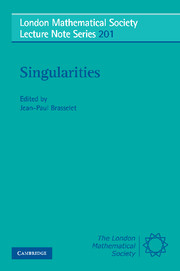Book contents
- Frontmatter
- Contents
- Introduction
- Plenary Conferences
- Specialized Conferences
- List of participants
- On Complex Projective Hypersurfaces which are Homology-Pn's
- Generic Geometry and Duality
- An arithmetical factorization for the critical point set of some map germs from C2 to C2
- Trivializations of stratified spaces with bounded differential
- Moduli for Singularities
- Conormal space and Jacobian modules: A short dictionary
- Weak Lefschetz and Topological q-Completeness
- Volumes and lattice points - proof of a conjecture of L. Ehrenpreis
- Connexions méromorphes
- Deformations of maps on complete intersections, Damon's Kv-equivalence and bifurcations
- Cycles évanescents et faisceaux pervers II: cas des courbes planes réductibles
- A Desingularization Theorem for Systems of Microdifferential Equations
- Topological Stability
- Boundary Fronts and Caustics and their Metamorphoses
- Quid des stratifications canoniques
- Irrégularité des revêtements cycliques
Topological Stability
Published online by Cambridge University Press: 05 May 2013
- Frontmatter
- Contents
- Introduction
- Plenary Conferences
- Specialized Conferences
- List of participants
- On Complex Projective Hypersurfaces which are Homology-Pn's
- Generic Geometry and Duality
- An arithmetical factorization for the critical point set of some map germs from C2 to C2
- Trivializations of stratified spaces with bounded differential
- Moduli for Singularities
- Conormal space and Jacobian modules: A short dictionary
- Weak Lefschetz and Topological q-Completeness
- Volumes and lattice points - proof of a conjecture of L. Ehrenpreis
- Connexions méromorphes
- Deformations of maps on complete intersections, Damon's Kv-equivalence and bifurcations
- Cycles évanescents et faisceaux pervers II: cas des courbes planes réductibles
- A Desingularization Theorem for Systems of Microdifferential Equations
- Topological Stability
- Boundary Fronts and Caustics and their Metamorphoses
- Quid des stratifications canoniques
- Irrégularité des revêtements cycliques
Summary
This article is an introductory account of work by the authors which is to appear in a book entitled “The geometry of topological stability”.
A C∞ map f : N → P between smooth manifolds is called Cr-stable if it has a neighbourhood W such that for any g ∈ W there exist Cr-diffeomorphisms p of N, λ of P with g = λ o f o p. If λ and p depend continuously on g, we call f strongly stable.
We will concentrate on the case when N is compact. The results can be extended to the general case, but matters become much more complicated, partly because we have a choice of topologies on the spaces C∞(N,P) (of C∞-mappings) etc - on the whole, the Whitney topologies are the most appropriate - leading to many variants of the definition of stability, which are demonstrably not all equivalent, so that it is harder to match up necessary with sufficient conditions for stability. To hint at the kind of considerations involved we draw attention to a generalisation of properness which plays an important rôle. We say f is quasi-proper if the discriminant Δ(f) has a neighbourhood U in P such that the restriction of f to f-1U is proper. Then the condition of being quasi-proper is necessary for versions of C°-stability requiring some kind of uniformity in the Whitney topology though not for C°-stability per se.
- Type
- Chapter
- Information
- Singularities , pp. 351 - 362Publisher: Cambridge University PressPrint publication year: 1994
- 3
- Cited by

